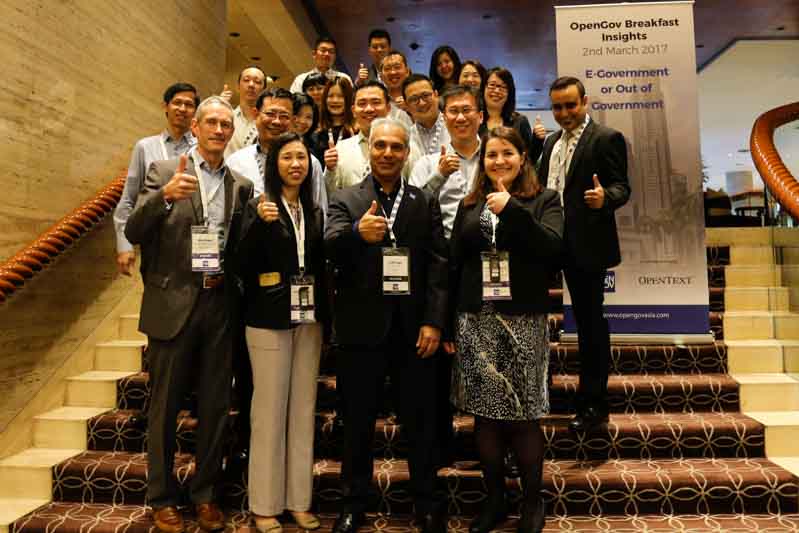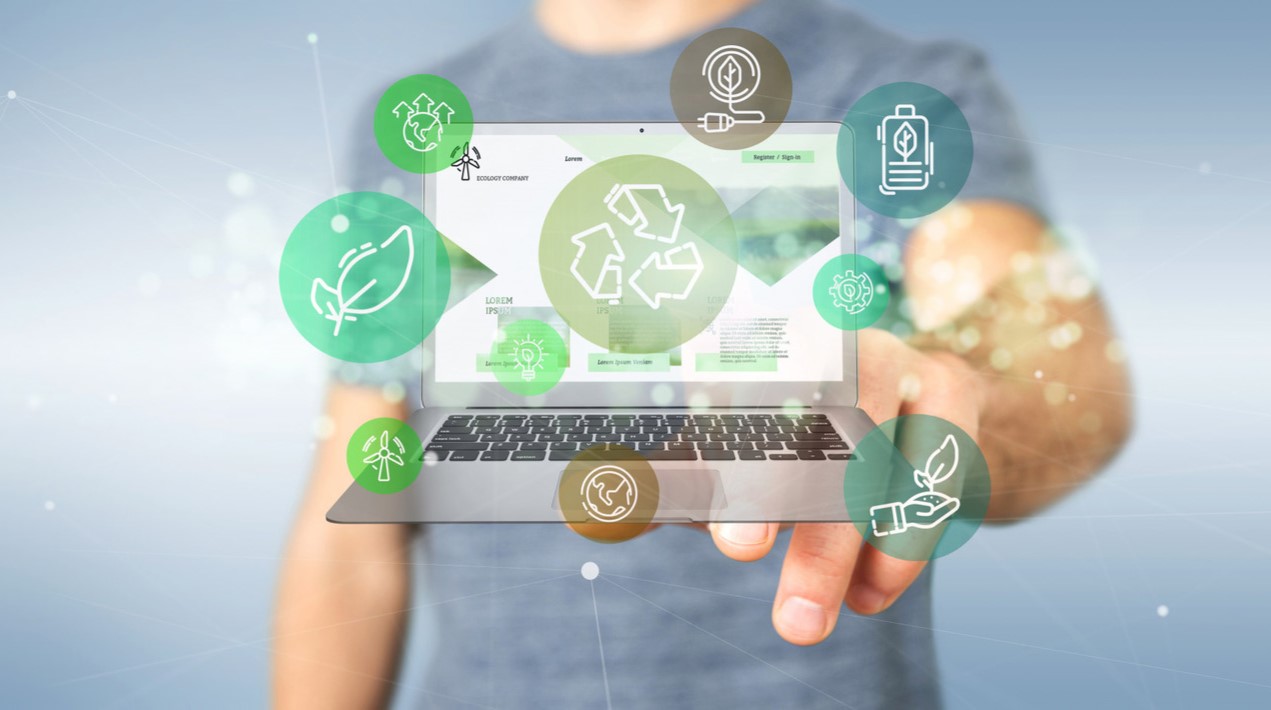
OpenGov held its first Breakfast Insights session for 2017 at Sheraton Towers Hotel, Singapore on March 2. Government representatives from 11 Singapore government agencies shared their experience and insights on the challenges of digital transformation and delivering quality e-services for citizens. The session was facilitated by Mr. Mohit Sagar, Managing Director and Editor-In-Chief of OpenGov Asia. Mr. Mike Hooper, Director, Solutions Consulting, Asia, OpenText (Asia) began the session with how digital disruption is changing the way people live and both governments and businesses have to change accordingly to stay relavant, such as providing services 24/7. Real value comes not from technology alone but ultimately from people, being able to reap value from shared services and getting real insights from data.
Former Agile Business Analyst, Digital Transformation Agency (DTA) of the Australian government, Ms. Catherine Edwards, shared that governments have the moral obligation to do right by their citizens by providing relevant services and platforms for them. She explained from her time working for the Australia government:
“I have watched, in a matter of 5 years, the rapid transformation from business and government–centred needs to now, user-centred needs as well.” Continuing the theme of service delivery and user-centred approach, Ms. Stephanie Kwok (below photo,left) CIO, Vital Shared Services, Singapore stated that the mission of her agency is to deliver quality shared services for the whole of government, with the intent of bringing better value overall.

Vital has embarked on a 5-year transformation road map (2015-2020) to work towards the next frontier, looking at how technology can enable Vital’s transformation journey. In 2016, Vital had just implemented their first digital and integrated government e-document, a platform for proper workflow documentation to digitalise manual processes internally, with the goal of helping the whole of Singapore government digitalise in a similar manner. Ms. Kwok also added that Vital believes in having strong partnerships with other government agencies to know exactly what the needs of other agencies are and eventually providing them with value-added services. Vital also believes in increasing the capabilities of its staff for them to better do their jobs and be future-ready.
Themes and discussion
Citizen-centric services and user experience
An engaging discussion between the participants of the session followed with the series of polling questions posted, with many of the government representatives providing real life examples and lessons from their respective agencies and past experiences. On the topic of delivering citizen-centric services, a consistent message from the discussion questions was making services easily accessible and providing multiple channels for citizens.

According to Mr. Ramachandran Narayanan (above photo, left), Director Systems, Applications & Operations, National Library Board (NLB), the organisation has been focusing on digitalisation and accessibility for the past 5 years: “E-books are available through mobile apps and we are looking at how to make the National Archives and historical records more accessible to citizens in one place and using smart engines to aid search queries with the given keywords. We also engage with the citizens to get their feedback on how to classify historical documents, we call them ‘citizen archivists’.” Ms. Edwards (former DTA staff) (above photo, right) responded to Mr. Narayanan with the example of an unexpected benefits of archiving and digitising past records- an Australian family was able to connect to their grandmother suffering from dementia through accessing old womens’ magazines from the 1940s-50s which were digitally archived.
Providing citizens multiple channels of accessibility for its services was brought up by Ms. Lim Leh Hoon, Assistant Director, Information Services, Organisation Enablement, Singapore Tourism Board (STB) who mentioned that it is not sufficient to just provide services through conventional web portals but also to look at citizen engagement through other platforms such as mobile devices and smart kiosks.
While providing citizens with easy to access services through multiple platforms is important, Mr. Kwok Qwek Sin, Director (Government Digital Services Product Management), Government Technology Agency of Singapore (GovTech), commented that although the Singapore government is very good at delivering functional services, it also needs to think about whether the services are engaging enough to the citizens. Mr. Kwok gave the statistic that the average citizen deals with government about 25 times a year but deals with banks and other private companies much more. The challenge is for government then is to think about how to deliver e-services as part of a larger ecosystem of related services rather than from just a standalone government agency. For instance, government agencies could work with institutions such as banks to deliver e-services.
Innovation, collaboration and adding value
Almost all the representatives from the various government agencies agreed that innovation and progressing in the journey of digital transformation starts not just within the government agencies themselves but through collaboration and knowledge sharing with other government agencies to bring about value and positive outcomes. Ms. Ong Poh Poh, Director, Service & Innovation, Vital Shared Services, Singapore gave the example of a mobile app device her agency had developed to help civil servants with their work-related transport claims. So far 7 government agencies have been using the service and Vital hopes they can expand the service to more government agencies and streamline their claims process. An open data concept is adopted by the NLB and Mr. Narayanan believes that partnerships with other government agencies and sharing of relevant data sets with them will bring about insights which will be beneficial to both government agencies and eventually citizens in the long-term.
Digital transformation and its challenges
One of the key challenges in the digital transformation process which was brought up by many of the government agencies represented at the Breakfast Insights session was managing resources (people, technologies and expertise) and budget allocation.

For Mr. Darren Chan (above photo, left), CIO, Intellectual Property Office of Singapore (IPOS), the organisation is self-funded and because of that budget is very tight, ROIs are defined for every project and sometimes the digital transformation process is not so easy. Additionally, there are competing projects within the organisation and resources are tight as IPOS supports 3 subsidaries and a lot of prioritisation has been done.
Similarly for Mr. Richard Lee, Director, Capability Development Division, Skills Future Singapore, he explained that Skills Future is supporting 2 statutory boards and there is a constraint on resources, especially when projects come in from the statutory boards. A prioritisation road map is in place and it is challenging to take on other projects that are outside of the road map. Another component that is important in the digital transformation process is ensuring knowledge transfer between teams in a government agency, which more often than not, is difficult to achieve.
Although it is easy to build a Knowledge Management System, the key challenge after that is to keep it constantly updated and maintained. Mr. Rupert Gwee, Director (NS Affairs Directorate & Human Resource Transformation Office), Ministry of Home Affairs suggested that it is not about building a system but building a community to facilitate knowledge transfer between teams in an agency.
















